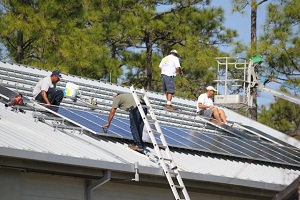Florida's National Audubon Society receives free solar array
 The National Audubon Society’s Blair Center at the Corkscrew Swamp Sanctuary went live with a donated solar array on Jan. 29.
The National Audubon Society’s Blair Center at the Corkscrew Swamp Sanctuary went live with a donated solar array on Jan. 29.
California-based REC Solar donated the system to the Audubon for its ecosystem restoration efforts and its work saving birds during the oil spill that ravaged the shores of Louisiana in the summer of 2010.
The system will allow the Naples, Fla., bird sanctuary to derive most of its electric needs from the 10-kilowatt, rooftop-mounted array commissioned on Saturday.
While the Audubon does have a sanctuary in Louisiana, Audubon spokesperson Delta Willis said they determined Naples was the best location.
“It was the closest sanctuary to the gulf, where we had a suitable location for solar to work,” she said.
The Florida site was selected for a number of reasons. Among the reasons the Audubon cited were because the Florida arm of the Audubon Society did a lot of oil spill recovery work, and because conditions at Corkscrew were ideal for solar energy.
The solar panels at the sanctuary are also visible to visitors of the sanctuary, Willis explained.
“The Blair Center gets 100,000 visitors a year,” she said. The visibility and high traffic at the sanctuary helps show Audubon’s commitment to sustainability.
The Blair Center is part of the 13,000-acre sanctuary that’s home to the largest stand of old-growth Bald Cypress in North America and home to the endangered Wood Stork, 200 other bird species, the Florida panther and the rare Ghost Orchid—the inanimate star of the book The Orchid Thief and subsequent film Adaptation.
In a press release announcing the donation, Kam Mofid, president of REC Solar said, “We were deeply moved by the Gulf Coast disaster and haven’t forgotten its impact on the people, wildlife and environment of the region. We’ve been so impressed with all that Audubon is doing in the Gulf that we wanted to give them a gift that will keep on giving.”
REC cited Audubon’s recovery efforts, which included Audubon’s volunteer response supporting bird rescues, its ongoing citizen-science monitoring activities, and the organization’s long-term efforts to restore threatened Gulf of Mexico ecosystems.
Image courtesy of the National Audubon Society.



